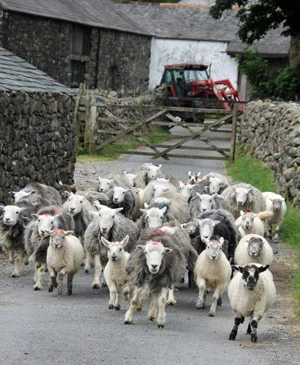Choosing Mutton
How do you choose what mutton to buy?
Advice from history, added to modern criteria help today's consumer decide.
When buying mutton, here are some questions to ask.
Butchering a mutton leg
Whilst there is no such thing as ‘just’ a bottle of wine, so it is with mutton. There are many variables which contribute to great eating mutton – the age, breed, feeding, the environment where the animal was grown, the hanging of the meat, and so on. One cannot make generalisations about quality and flavour of all mutton. In 1954 Dorothy Hartley had some characteristically sound advice ‘Do not treat all mutton in the same way, and always differentiate between lamb and mutton by quality, not size... The mountain breeds never put on fat like the Lowland mutton, and the spicy thyme and herb fodder of the hills makes them much the best mutton obtainable.’
So, how do you choose what mutton to buy? Here are some questions to ask when buying - as easy to remember as ABCD:
AGE - how old was the animal?
To the Victorians, the optimum age of the animal was 2 to 5 and more years – all had their advocates, as did those who preferred wether animals, and others who thought nothing bettered ewe mutton.
BREED - what Breed of Sheep is it?
Cumbrian Herdwick Sheep
A major debating point for the Victorians and before, concerned breeds. In its heyday, there were grades of excellence of mutton breeds, from what many considered to be the rather tasteless and fatty English Longwool breeds; to the incomparable Downland breeds, especially Southdown; the mountain breeds such as Welsh Mountain, Blackface and Herdwick; and the primitive, oldest established breeds, such as the Soay and Hebridean.
CHILLING/HANGING was the carcass traditionally hung, and if so, for how long?
Mutton Carcass
The traditional ageing of the meat through hanging the carcass was considered obligatory by most people until the advent of the supermarkets. The discussions would be over not whether, but for how long, to hang the carcass. At least 10 days is said to produce the tenderest, tastiest mutton, and many Victorian writers referred to "as long as it would take" .
DIET - on what was the animal fed, and where did it live?
Many Victorians believed the flora found on Britain’s hill and mountain tops was a major contributor to the flavour of the meat. The diet also controls the speed of growth which any people consider affects the quality and flavour of the meat - the slower the better for the best flavour. In addition, the salty grasses of the coast of England and Wales produces the famous Salt Marsh mutton, with its characteristic flavour.
Mutton Rack (French Trim)
Past Wisdom on Buying Mutton
With all these variables, how did people choose their mutton in the past? Everyone had their opinion on what made the best type. In the days before pre-packaged standard meat from supermarkets, buying meat required considerably more knowledge than today. Mrs Beeton in 1861 considered the best joint of mutton to be a saddle ‘Although we have heard, at various intervals, growlings expressed at the inevitable ‘saddle of mutton’ at the dinner-parties of our middle classes, yet we doubt whether any other joint is better liked, when it has been well hung and artistically cooked.’
A. M. Ude, writing in 1849 had simple advice on buying the best mutton ‘Always choose mutton of a dark colour and marblelike appearance.’ According to Selfridge’s Household Encyclopaedia of 1929, ‘The flesh of mutton should be fine grained and firm, paler in colour than beef; the fat white and firm. Mutton is at its finest when between four and five years old; but it is seldom met with. Sheep are generally killed when between two and three years old.’
“‘Now suppose, my pet, that you were married, and you were going to buy a shoulder of mutton for dinner, would you know how to buy it?’”



